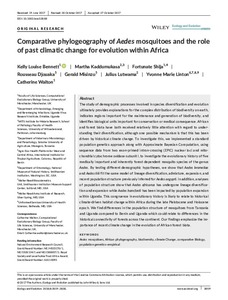| dc.contributor.author | Bennett, K.L. |
| dc.contributor.author | Kaddumukasa, M. |
| dc.contributor.author | Shija, F. |
| dc.contributor.author | Djouaka, R. |
| dc.contributor.author | Misinzo, G. |
| dc.contributor.author | Lutwama, J. |
| dc.contributor.author | Linton, Y.M. |
| dc.contributor.author | Walton, C. |
| dc.date.accessioned | 2019-12-04T11:30:04Z |
| dc.date.available | 2019-12-04T11:30:04Z |
| dc.date.issued | 2018-03 |
| dc.identifier.citation | Bennett, K.L., Kaddumukasa, M., Shija, F., Djouaka, R., Misinzo, G., Lutwama, J., ... & Walton, C. (2018). Comparative phylogeography of Aedes mosquitoes and the role of past climatic change for evolution within Africa. Ecology and Evolution, 8(5), 3019-3036. |
| dc.identifier.issn | 2045-7758 |
| dc.identifier.uri | https://hdl.handle.net/20.500.12478/5178 |
| dc.description | Open Access Journal; Published online: 16 Feb 2018 |
| dc.description.abstract | The study of demographic processes involved in species diversification and evolution ultimately provides explanations for the complex distribution of biodiversity on earth, indicates regions important for the maintenance and generation of biodiversity, and identifies biological units important for conservation or medical consequence. African and forest biota have both received relatively little attention with regard to understanding their diversification, although one possible mechanism is that this has been driven by historical climate change. To investigate this, we implemented a standard population genetics approach along with Approximate Bayesian Computation, using sequence data from two exon‐primed intron‐crossing (EPIC) nuclear loci and mitochondrial cytochrome oxidase subunit I, to investigate the evolutionary history of five medically important and inherently forest dependent mosquito species of the genus Aedes. By testing different demographic hypotheses, we show that Aedes bromeliae and Aedes lilii fit the same model of lineage diversification, admixture, expansion, and recent population structure previously inferred for Aedes aegypti. In addition, analyses of population structure show that Aedes africanus has undergone lineage diversification and expansion while Aedes hansfordi has been impacted by population expansion within Uganda. This congruence in evolutionary history is likely to relate to historical climate‐driven habitat change within Africa during the late Pleistocene and Holocene epoch. We find differences in the population structure of mosquitoes from Tanzania and Uganda compared to Benin and Uganda which could relate to differences in the historical connectivity of forests across the continent. Our findings emphasize the importance of recent climate change in the evolution of African forest biota. |
| dc.format.extent | 3019-3036 |
| dc.language.iso | en |
| dc.rights | CC-BY-4.0 |
| dc.subject | Biodiversity |
| dc.subject | Climate Change |
| dc.subject | Population Genetics |
| dc.subject | Africa |
| dc.subject | Culicidae |
| dc.title | Comparative phylogeography of Aedes mosquitoes and the role of past climatic change for evolution within Africa |
| dc.type | Journal Article |
| dc.description.version | Peer Review |
| cg.contributor.crp | Agriculture for Nutrition and Health |
| cg.contributor.affiliation | University of Manchester |
| cg.contributor.affiliation | Uganda Virus Research Institute |
| cg.contributor.affiliation | Sokoine University of Agriculture |
| cg.contributor.affiliation | International Institute of Tropical Agriculture |
| cg.contributor.affiliation | Smithsonian Institution, Washington |
| cg.coverage.region | Africa |
| cg.coverage.region | East Africa |
| cg.coverage.region | West Africa |
| cg.coverage.country | Benin |
| cg.coverage.country | Tanzania |
| cg.coverage.country | Uganda |
| cg.creator.identifier | Rousseau Djouaka: 0000-0003-4772-0753 |
| cg.researchtheme | NUTRITION & HUMAN HEALTH |
| cg.isijournal | ISI Journal |
| cg.authorship.types | CGIAR and developing country institute |
| cg.iitasubject | Climate Change |
| cg.iitasubject | Disease Control |
| cg.iitasubject | Nutrition |
| cg.journal | Ecology and Evolution |
| cg.howpublished | Formally Published |
| cg.accessibilitystatus | Open Access |
| local.dspaceid | 102671 |
| cg.targetaudience | Scientists |
| cg.identifier.doi | https://dx.doi.org/10.1002/ece3.3668 |

